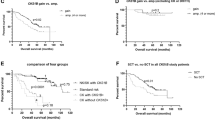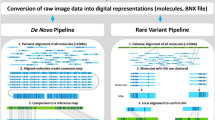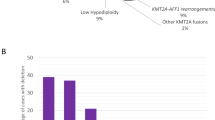Abstract
A simple high throughput micro-fluorescence in situ hybridisation technique (FISH) was used to detect chromosome 13 deletions (Δ13), immunoglobulin heavy chain (IgH) rearrangements, t(11;14)(q13;q32), t(4;14)(p16;q32), t(14;16)(q23;q32), p53 loss, and numerical changes of chromosomes 3, 6, 7, 9, 10, 11 and 17 in 228 cases of multiple myeloma (MM), including 33 asymptomatic/smouldering MM (SMM). The patients were not part of a clinical trial and were from 30 different hospitals. In all, 98.4% of cases were abnormal, with 43% having IgH rearrangements and 42% Δ13. The low incidence of IgH rearrangements was due to a decrease in this finding with age (P=0.001) and the relatively high proportion of elderly patients in our study population (41% >70 years old). The incidence of specific IgH translocations was t(4;14) 11%, t(11;14) 16% and t(14;16) 3%. Univariate statistical testing showed Δ13 (P=0.002), and t(14;16) (P=0.005) to be associated with shorter survival. This effect was exaggerated for patient's aged 70 years or under but no effect on survival was seen for those over 70 years. In younger patients t(4;14) (P=0.044) and p53 deletion (P<0.001) were also significant poor prognostic indicators. Multivariate analysis showed Δ13 and t(14;16) to be independent prognostic variables when considered with age and clinical parameters.
This is a preview of subscription content, access via your institution
Access options
Subscribe to this journal
Receive 12 print issues and online access
$259.00 per year
only $21.58 per issue
Buy this article
- Purchase on Springer Link
- Instant access to full article PDF
Prices may be subject to local taxes which are calculated during checkout


Similar content being viewed by others
References
Brigaudeau C, Trimoreau F, Gachard N, Rouzier E, Jaccard A, Bordessoule D et al. Cytogenetic study of 30 patients with multiple myeloma: comparison of 3 and 6-day bone marrow cultures stimulated or not with cytokines by using a miniaturized karyotypic method. Br J Haematol 1997; 96: 594–600.
Smadja NV, Fruchart C, Isnard F, Louvet C, Dutel JL, Cheron N et al. Chromosomal analysis in multiple myeloma: cytogenetic evidence of two different diseases. Leukemia 1998; 12: 960–969.
Fassas AB, Spencer T, Sawyer J, Zangari M, Lee CK, Anaissie E et al. Both hypodiploidy and deletion of chromosome 13 independently confer poor prognosis in multiple myeloma. Br J Haematol 2002; 118: 1041–1047.
Zandecki M, Lai JL, Facon T . Multiple myeloma: almost all patients are cytogenetically abnormal. Br J Haematol 1996; 94: 217–227.
Perez-Simon JA, Garcia-Sanz R, Tabernero MD, Almeida J, Gonzalez M, Fernandez-Calvo J et al. Prognostic value of numerical chromosome aberrations in multiple myeloma: a FISH analysis of 15 different chromosomes. Blood 1998; 91: 3366–3371.
Tricot G, Barlogie B, Jagannath S, Bracy D, Mattox S, Vesole DH et al. Poor prognosis in multiple myeloma is associated only with partial or complete deletions of chromosome 13 or abnormalities involving 11q and not with other karyotype abnormalities. Blood 1995; 86: 4250–4256.
Facon T, Avet-Loiseau H, Guillerm G, Moreau P, Genevieve F, Zandecki M et al. Chromosome 13 abnormalities identified by FISH analysis and serum beta2-microglobulin produce a powerful myeloma staging system for patients receiving high-dose therapy. Blood 2001; 97: 1566–1571.
Fonseca R, Harrington D, Oken MM, Dewald GW, Bailey RJ, Van Wier SA et al. Biological and prognostic significance of interphase fluorescence in situ hybridization detection of chromosome 13 abnormalities (delta13) in multiple myeloma: an eastern cooperative oncology group study. Cancer Res 2002; 62: 715–720.
Kaufmann H, Kromer E, Nosslinger T, Weltermann A, Ackermann J, Reisner R et al. Both chromosome 13 abnormalities by metaphase cytogenetics and deletion of 13q by interphase FISH only are prognostically relevant in multiple myeloma. Eur J Haematol 2003; 71: 179–183.
Moreau P, Facon T, Leleu X, Morineau N, Huyghe P, Harousseau JL et al. Recurrent 14q32 translocations determine the prognosis of multiple myeloma, especially in patients receiving intensive chemotherapy. Blood 2002; 100: 1579–1583.
Fonseca R, Blood EA, Oken MM, Kyle RA, Dewald GW, Bailey RJ et al. Myeloma and the t(11;14)(q13;q32); evidence for a biologically defined unique subset of patients. Blood 2002; 99: 3735–3741.
Fonseca R, Barlogie B, Bataille R, Bastard C, Bergsagel PL, Chesi M et al. Genetics and cytogenetics of multiple myeloma: a workshop report. Cancer Res 2004; 64: 1546–1558.
Drach J, Ackermann J, Fritz E, Kromer E, Schuster R, Gisslinger H et al. Presence of a p53 gene deletion in patients with multiple myeloma predicts for short survival after conventional-dose chemotherapy. Blood 1998; 92: 802–809.
Schultheis B, Kramer A, Willer A, Hegenbart U, Goldschmidt H, Hehlmann R . Analysis of p73 and p53 gene deletions in multiple myeloma. Leukemia 1999; 13: 2099–2103.
Chang H, Qi C, Yi QL, Reece D, Stewart AK . p53 gene deletion detected by fluorescence in situ hybridization is an adverse prognostic factor for patients with multiple myeloma following autologous stem cell transplantation. Blood 2005; 105: 358–360.
Smadja NV, Bastard C, Brigaudeau C, Leroux D, Fruchart C . Hypodiploidy is a major prognostic factor in multiple myeloma. Blood 2001; 98: 2229–2238.
Debes-Marun CS, Dewald GW, Bryant S, Picken E, Santana-Davila R, Gonzalez-Paz N et al. Chromosome abnormalities clustering and its implications for pathogenesis and prognosis in myeloma. Leukemia 2003; 17: 427–436.
Shaughnessy J, Jacobson J, Sawyer J, McCoy J, Fassas A, Zhan F et al. Continuous absence of metaphase-defined cytogenetic abnormalities, especially of chromosome 13 and hypodiploidy, ensures long-term survival in multiple myeloma treated with Total Therapy I: interpretation in the context of global gene expression. Blood 2003; 101: 3849–3856.
Hideshima T, Bergsagel PL, Kuehl WM, Anderson KC . Advances in biology of multiple myeloma: clinical applications. Blood 2004; 104: 607–618.
Davies FE, Dring AM, Li C, Rawstron AC, Shammas MA, O'Connor SM et al. Insights into the multistep transformation of MGUS to myeloma using microarray expression analysis. Blood 2003; 102: 4504–4511.
Kuehl WM, Bergsagel PL . Multiple myeloma: evolving genetic events and host interactions. Nat Rev Cancer 2002; 2: 175–187.
Avet-Loiseau H, Facon T, Grosbois B, Magrangeas F, Rapp MJ, Harousseau JL et al. Oncogenesis of multiple myeloma: 14q32 and 13q chromosomal abnormalities are not randomly distributed, but correlate with natural history, immunological features, and clinical presentation. Blood 2002; 99: 2185–2191.
Fonseca R, Blood E, Rue M, Harrington D, Oken MM, Kyle RA et al. Clinical and biologic implications of recurrent genomic aberrations in myeloma. Blood 2003; 101: 4569–4575.
Fonseca R, Debes-Marun CS, Picken EB, Dewald GW, Bryant SC, Winkler JM et al. The recurrent IgH translocations are highly associated with nonhyperdiploid variant multiple myeloma. Blood 2003; 102: 2562–2567.
Durie BG, Kyle RA, Belch A, Bensinger W, Blade J, Boccadoro M et al. Myeloma management guidelines: a consensus report from the Scientific advisors of the international Myeloma foundation. Hematol J 2004; 5: 285.
Jacobson JL, Hussein MA, Barlogie B, Durie BG, Crowley JJ . A new staging system for multiple myeloma patients based on the Southwest Oncology Group (SWOG) experience. Br J Haematol 2003; 122: 441–450.
Gabrea A, Bergsagel PL, Chesi M, Shou Y, Kuehl WM . Insertion of excised IgH switch sequences causes overexpression of cyclin D1 in a myeloma tumor cell. Mol Cell 1999; 3: 119–123.
Santra M, Zhan F, Tian E, Barlogie B, Shaughnessy Jr J . A subset of multiple myeloma harboring the t(4;14)(p16;q32) translocation lacks FGFR3 expression but maintains an IGH/MMSET fusion transcript. Blood 2003; 101: 2374–2376.
Keats JJ, Reiman T, Maxwell CA, Taylor BJ, Larratt LM, Mant MJ et al. In multiple myeloma, t(4;14)(p16;q32) is an adverse prognostic factor irrespective of FGFR3 expression. Blood 2003; 101: 1520–1529.
Wuilleme S, Robillard N, Lode L, Magrangeas F, Beris H, Harousseau JL et al. Ploidy, as detected by fluorescence in situ hybridization, defines different subgroups in multiple myeloma. Leukemia 2005; 19: 275–278..
Fonseca R, Oken MM, Greipp PR . The t(4;14)(p16.3;q32) is strongly associated with chromosome 13 abnormalities in both multiple myeloma and monoclonal gammopathy of undetermined significance. Blood 2001; 98: 1271–1272.
Diagnosis and management of multiple myeloma. Br J Haematol 2001; 115: 522–540.
Avet-Loiseau H, Li JY, Morineau N, Facon T, Brigaudeau C, Harousseau JL et al. Monosomy 13 is associated with the transition of monoclonal gammopathy of undetermined significance to multiple myeloma. Intergroupe Francophone du Myelome. Blood 1999; 94: 2583–2589.
Acknowledgements
This work was supported by grants from the Leukaemia Research Fund and Bud Flanagan Leukaemia Fund.
Author information
Authors and Affiliations
Consortia
Corresponding author
Appendix A
Appendix A
List of referring hospitals and consultants

Rights and permissions
About this article
Cite this article
Ross, F., Ibrahim, A., Vilain-Holmes, A. et al. Age has a profound effect on the incidence and significance of chromosome abnormalities in myeloma. Leukemia 19, 1634–1642 (2005). https://doi.org/10.1038/sj.leu.2403857
Received:
Accepted:
Published:
Issue Date:
DOI: https://doi.org/10.1038/sj.leu.2403857
Keywords
This article is cited by
-
The relative importance of factors predicting outcome for myeloma patients at different ages: results from 3894 patients in the Myeloma XI trial
Leukemia (2020)
-
Mutational processes contributing to the development of multiple myeloma
Blood Cancer Journal (2019)
-
Pretreatment 18F-FDG PET/CT combined with quantification of clonal circulating plasma cells as a potential risk model in patients with newly diagnosed multiple myeloma
European Journal of Nuclear Medicine and Molecular Imaging (2019)
-
Challenges and Promises of Genetic Stratification of Risk in Multiple Myeloma
Indian Journal of Hematology and Blood Transfusion (2017)
-
Translocations at 8q24 juxtapose MYC with genes that harbor superenhancers resulting in overexpression and poor prognosis in myeloma patients
Blood Cancer Journal (2014)



